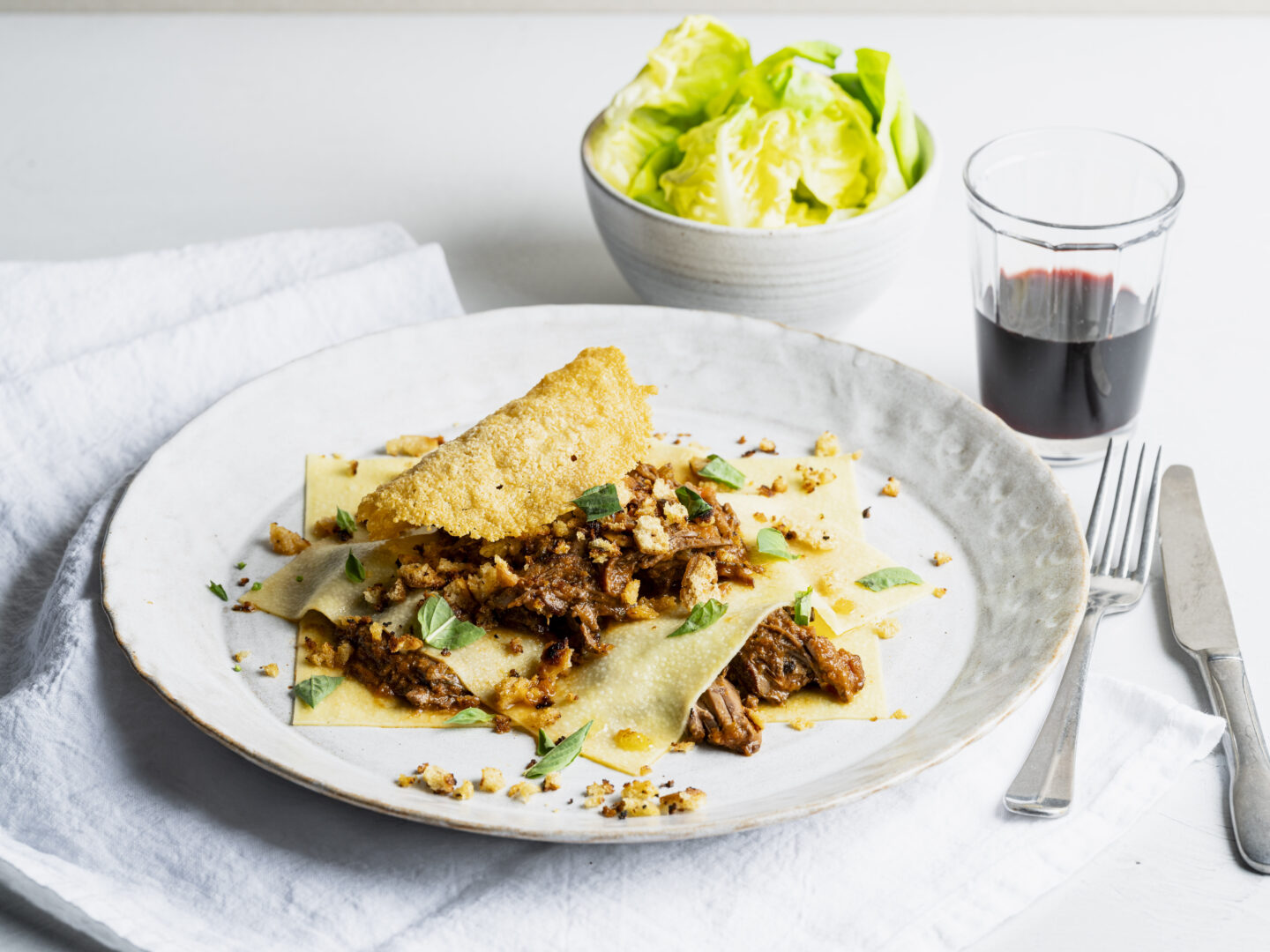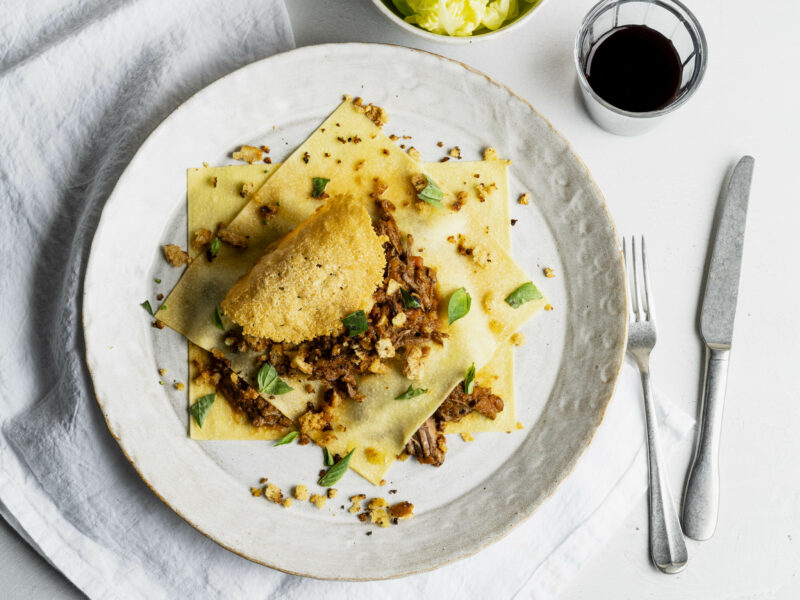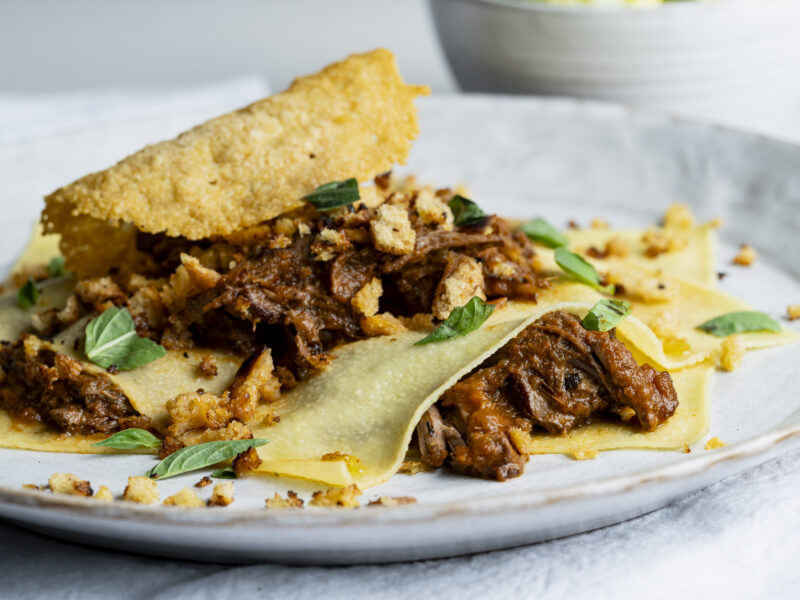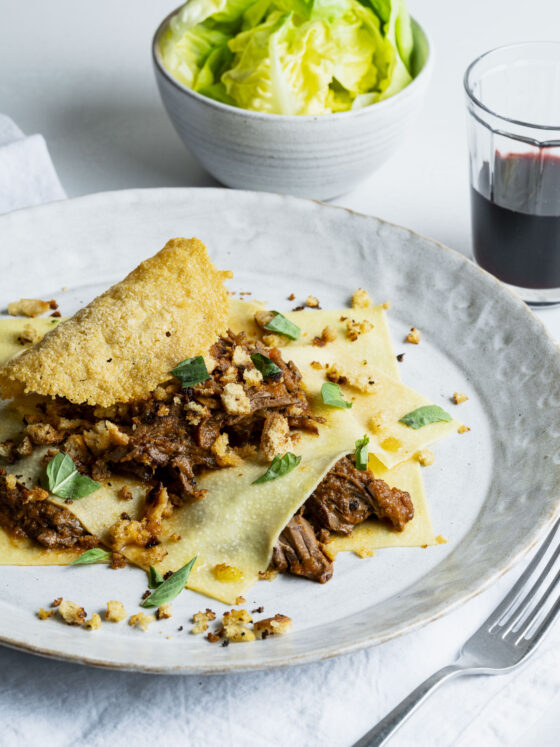Lasagna with beef ragout and pangrattato
Beef ragout is a dish that has been enjoyed in many cultures for centuries, with each country or region adding its own unique twist. In Italy, the popular ragout alla bolognese is typically served with pasta, while in France, the traditional boeuf bourguignon is a dish that is famous for its use of red wine. In Belgium, a variation of the dish, Flemish carbonnade, is prepared using beer and mustard, adding a local specialty to an already delicious meal. In Andalusia rabo de toro (oxtail stew) is renowned for its deep, rich flavour. And then there's England, where I tasted the most delicious Cornish pasty with braised beef, potato and turnips. All these dishes have one thing in common, and that's slow-cooked beef that is super tender and has a deep, delicious flavour.
Inspired by my travels, I decided to create my own version of beef ragout, serving it with sheets of lasagna - an idea I picked up from Armani Caffé in Milan. In this lasagna, I combine the savoury flavour of braised beef with the crunchy texture of pangrattato (toasted breadcrumbs) to create a delightful and elegant dish.

Where did the word 'ragout' come from?
The word 'ragout' has been adopted in many languages. For example, you'll find 'ragout' in French, English, Dutch, German and Portuguese. In Spain and Italy, people speak of 'ragú' or 'ragù'. The word actually comes from the French verb 'ragoûter', which can be translated as 'to whet the appetite'.
Ragout in all its forms
Ragout was traditionally made with meat, poultry or fish leftovers, simmered in a rich sauce. These days, ragout is made with nice cuts of meat, and it's become a real delicacy in its own right. Here are some popular types of ragout:
- Beef ragout: pieces of beef simmered in a rich sauce, often based on wine or beer. Examples include boeuf bourguignon, Flemish carbonnade and Italian ragù.
- Chicken ragout: chicken ragout is usually served with a béchamel sauce in a pastry pie. We know this dish as “bouchée à la reine”.
- Veal ragout: here, veal is combined with mushrooms and a cream sauce, the typical veal blanquette.
- Fish ragout: different types of fish and seafood are usually served in a creamy sauce topped with breadcrumbs and baked in the oven, in short fish pie.
- Lamb ragout: a favourite in the Middle East, prepared with a mix of spices and served with rice or couscous.
- Vegetable ragout: a vegetarian version you can make with all kinds of seasonal veg, like carrots, mushrooms, peas and cauliflower.
- Game ragout: And for something really special, why not try game ragout? This is perfect during hunting season, and is made with a rich, concentrated sauce based on game stock and wine.
Ragout is a very versatile dish. You can serve it with potatoes, over rice or polenta, with pasta or au gratin. If you thicken the ragout, you can make delicious croquettes or use it as a savoury filling for pies or puff pastry.

Recipe: lasagna with beef ragout and pangrattato

Ingredients for 4 people:
- 1 kg meat for beef stew
- 2 tablespoons of olive oil
- 1 onion
- 2 cloves of garlic
- 1 carrot
- 1 celery stalk
- A few sprigs of thyme
- 1 sprig of rosemary
- 1 bay leaf
- 1 tablespoon tomato puree
- 1 tablespoon sherry vinegar
- 150 ml red wine
- 250 ml passata
- 500 ml beef stock
- Pepper and salt
- 8 sheets fresh lasagna
To serve:
- 50 g grated Parmesan cheese
- 4 slices of stale bread
- 2 tablespoons of olive oil
- 1 clove of garlic
- ¼ teaspoon chili powder
- Pepper and salt
- A few basil leaves
-
Step 1: Get everything ready
Cut the meat into chunks and season with salt and pepper. Chop the onion and garlic finely. Cut the carrot and celery into small pieces. Tie the sprigs of thyme, rosemary and bay leaf together with a piece of kitchen twine to form a bouquet garni.
-
Step 2: prepare beef ragout
Heat the olive oil in a casserole and brown the meat pieces on all sides. Remove the meat from the pan. Now add the onion and fry for 5 minutes until the onion is translucent. Add the garlic, carrot, celery, thyme, rosemary and bay leaf. Cook for a few minutes and then add the tomato puree. Continue cooking for 2 minutes, stirring constantly. Deglaze with the sherry vinegar. Now add the red wine to the pan and reduce by half. Add the meat along with the passata and beef stock. Bring to a gentle boil and simmer for 2 hours. Add a bit of stock or water if the ragout becomes too dry.
Remove the meat from the pan as soon as it is tender. Remove the bouquet garni. Put the sauce in a blender and blend until smooth. Add the meat pieces to the sauce and gently stir everything together.
-
Step 3: make pangrattato
Cut the crusts off the bread slices. Grind the bread into coarse crumbs and mix it with olive oil, pressed garlic,chili, pepper and salt. Next, fry the breadcrumbs in a pan until golden, about 5 minutes, then drain them on kitchen roll.
-
Step 4: Baking parmesan crackers
Preheat the oven to 180°C. Line a baking tray with baking paper and divide the Parmesan into rounds about 6 cm in diameter. Bake in the oven for 7 to 8 minutes until the cheese has melted and the edges of the crackers have turned golden brown. Then take them out of the oven and leave them to cool.
-
Step 5: boil the pasta
Bring a big pot of salted water to the boil, then cook the sheets of lasagna until they're al dente. With fresh pasta, this only takes a few minutes. Gently take them out of the water and drain on kitchen roll. Brush the lasagna sheets with a bit of olive oil.
-
Step 6: Serve
Place one sheet of lasagna on each plate, then add a spoonful of ragout. Next, add a second sheet of lasagna and another spoonful of ragout. Sprinkle with pangrattato, top with a cracker of Parmesan cheese and finish with a few basil leaves. A green salad and a glass of Chianti Classico will turn this simple dish into something really special.
![Lasagne Beefragout 605]()
